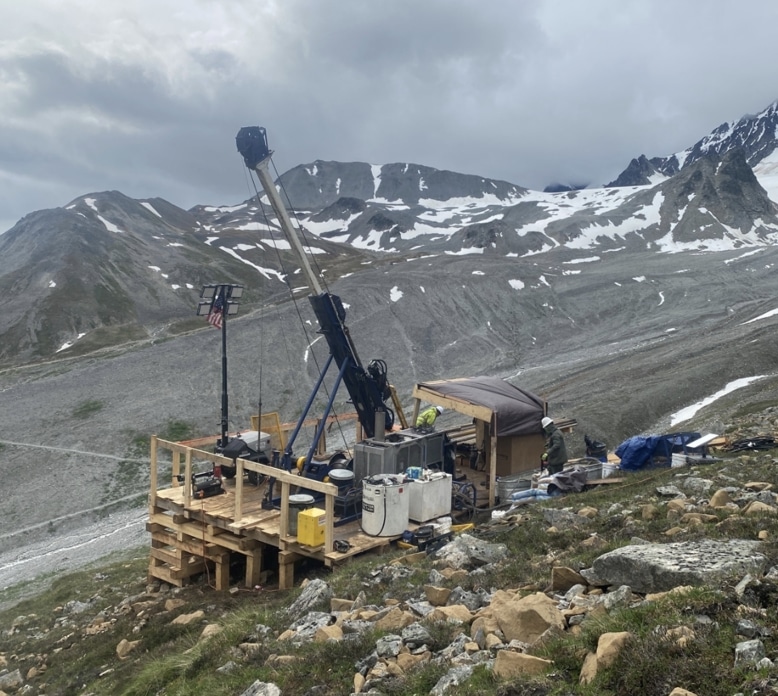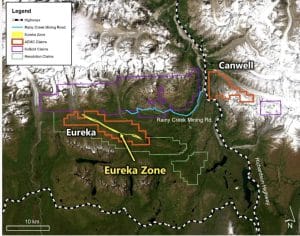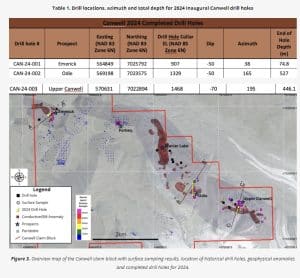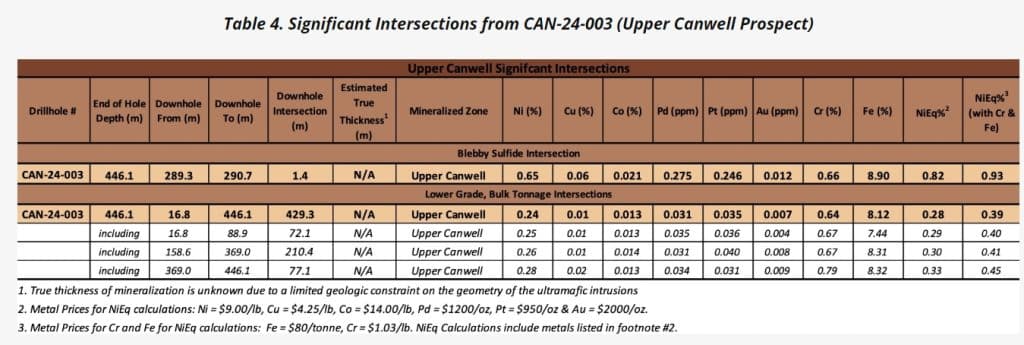Disseminated on behalf of Alaska Energy Metals Corporation.
Alaska Energy Metals Corporation (AEMC) has unveiled exciting findings from its 2024 inaugural exploration drilling program at the Canwell claim block which is a part of the Nikolai Project in Alaska. The Canwell area hosts three key prospects—Emerick, Odie, and Upper Canwell—located about 30 kilometers northeast of AEMC’s nickel-rich Eureka deposit.
AEMC’s Eureka Deposit: A Foundation for Growth
Exploring deeper, AEMC’s flagship Eureka deposit is a massive polymetallic resource with over 3.9 billion pounds of nickel in the Indicated category and 4.2 billion pounds in the Inferred category. This deposit also includes critical materials such as cobalt, chromium, platinum, and palladium. It also holds copper, iron, and gold which positions AEMC as a significant player in the strategic metals sector.
The advantage doesn’t end here, having such a rich resource potential aligns with U.S. government priorities for securing domestic supplies of strategic metals.
Nikolai Project – Property Location Map
Breaking Ground at Canwell: Promising Results for Nickel and Critical Metals
According to the company’s press release they used one surface diamond drill rig to drill three holes across the Emerick, Odie, and Upper Canwell prospects, covering a total of 1,047.9 meters. Each hole targeted geological, geophysical, and geochemical anomalies, providing valuable data for understanding the region’s mineralized ultramafic systems.
Alaska Energy Metals Chief Geologist Gabe Graf commented,
“After 20 years of limited exploration on the Canwell property, the information collected from these drill holes will aid our understanding of the mineralized ultramafic systems within the Wrangellia Terrane of interior Alaska. In fact, the blebby sulfides intersected at the Upper Canwell prospect is the first subsurface indication for higher-grade sulfides on the property. Furthermore, the potential for coarser-grained nickel sulfides and additional disseminated sulfide zones on the Nikolai Project is encouraging, and we are excited to continue advancing the geologic understanding of the property. We look forward to getting back into these areas in the next exploration season.”
Source: AEMC
- READ MORE: Nickel Could Be the Key to U.S. Energy Independence: Alaska Energy Metals’ Strategic Role
- READ MORE: The Nickel Market is Changing Big Time: Is a Supply-Demand Shift Underway?
Key Findings from the Drill Sites
1. Emerick Prospect (CAN-24-001)
Drill hole CAN-24-001 started with 16 meters of overburden, followed by serpentinized peridotite containing 0.2–0.5% sulfide minerals. The drilling reached a depth of 72.5 meters before encountering challenging rock conditions. These included intense fracturing, clay alteration, and serpentinization, which made sulfide estimation difficult.
Non-mineralized mafic dikes were also present within the peridotite. Drilling became harder due to poor rock quality, and the hole was abandoned at 74.8 meters due to a large fault. Unfortunately, it did not reach the targeted magnetic anomaly or the base of the ultramafic intrusion.
Rather than retrying, the team decided to postpone further drilling on this target until 2025. The key findings were:
- 56.5 meters @ 0.40% nickel equivalent (NiEq) (0.26% Ni, 0.62% Cr, 7.00% Fe, 0.012% Co, 0.01% Cu, 0.019 ppm Pd, 0.032 ppm Pt & 0.007 ppm Au)
Source: AEMC
2. Odie Prospect (CAN-24-002)
Drill hole CAN-24-002 started with 12.2 meters of overburden, followed by serpentinized dunite containing 0.2–6.0% nickel sulfide and Ni-Fe alloy. This mineralized zone extended to a depth of 245.5 meters. Within the dunite, several non-mineralized gabbroic dikes were found.
At 245.5 meters, the drill hit an unmineralized diorite intrusion, which continued down to 527.0 meters. The targeted DIGHEM magnetic anomaly is believed to mark the contact between the mineralized dunite and the diorite intrusion. This area also showed increased pyrrhotite content, offering valuable clues for further exploration. The team discovered:
- 193.6 meters @ 0.42% NiEq (0.26% Ni, 0.69% Cr, 8.58% Fe, 0.01% Cu, 0.014% Co, 0.035 ppm Pd, 0.041 ppm Pt and 0.007 ppm Au)
Source: AEMC
3. Upper Canwell Prospect (CAN-24-003)
Drill hole CAN-24-003 began with 16.8 meters of overburden, followed by serpentinized and faulted dunitic rocks. These rocks showed 0.5–5.0% nickel sulfide and Ni-Fe alloy mineralization. Several cross-cutting gabbroic dikes with minimal sulfide mineralization were also encountered.
Due to challenging terrain, the drill site was relocated north of the original plan. This adjustment allowed the team to test multiple geophysical targets and resulted in drilling down the dip of the intrusion.
The targeted DIGHEM magnetic anomaly showed higher sulfide content and better nickel grades, confirming its exploration potential. The key findings were:
- 429.3 meters @ 0.39% NiEq (0.24% Ni, 0.64% Cr, 8.12% Fe, 0.01% Cu, 0.013% Co, 0.031 ppm Pd, 0.035 ppm Pt and 0.007 ppm Au), including 1.4 meters @ 0.93 NiEq (0.65% Ni, 0.66% Cr, 8.90% Fe, 0.06% Cu, 0.021% Co, 0.275 ppm Pd, 0.246 ppm Pt and 0.012 ppm Au)
Source: AEMC
Ensuring High Standards for Exploration
AEMC upholds stringent Quality Assurance – Quality Control for its Nikolai Project to ensure the best practices for logging, sampling, and analysis of samples.
As revealed by the company,
“For every 10 core samples, geochemical blanks, coarse reject or pulp duplicates, or Ni-Cu-PGE-Au certified reference material standards (CRMs) were inserted into the sample stream.”
Furthermore, drill cores were flown daily to the McLaren River Lodge in Alaska, where they were meticulously logged, labeled, and cut. Half of each core was archived, while the other half was sent to SGS Laboratories in Burnaby, B.C., for detailed analysis using advanced geochemical methods.
This indicates that the company integrates environmental, social, and governance (ESG) principles into its operations. At the same time focusing on sustainable practices and carbon reduction. With offices in Anchorage and Vancouver, AEMC aims to supply critical materials essential for national security and clean energy.
What’s Next for AEMC?
Significantly, the recent results at Canwell strengthen the vision for district-wide exploration across the Nikolai Project. By confirming nickel mineralization and identifying promising areas for future drilling, AEMC has highlighted the potential for major discoveries in Alaska’s interior.
They plan to revisit the site in the 2025 season, targeting expanded sulfide zones and higher-grade nickel deposits. In addition to the Nikolai Project, AEMC is advancing the Angliers-Belleterre Project in Quebec, which holds potential for high-grade nickel-copper sulfides and white hydrogen.
Disclosure: Owners, members, directors, and employees of carboncredits.com have/may have stock or option positions in any of the companies mentioned: AEMC.
Carboncredits.com receives compensation for this publication and has a business relationship with any company whose stock(s) is/are mentioned in this article.
Additional disclosure: This communication serves the sole purpose of adding value to the research process and is for information only. Please do your own due diligence. Every investment in securities mentioned in publications of carboncredits.com involves risks that could lead to a total loss of the invested capital.







